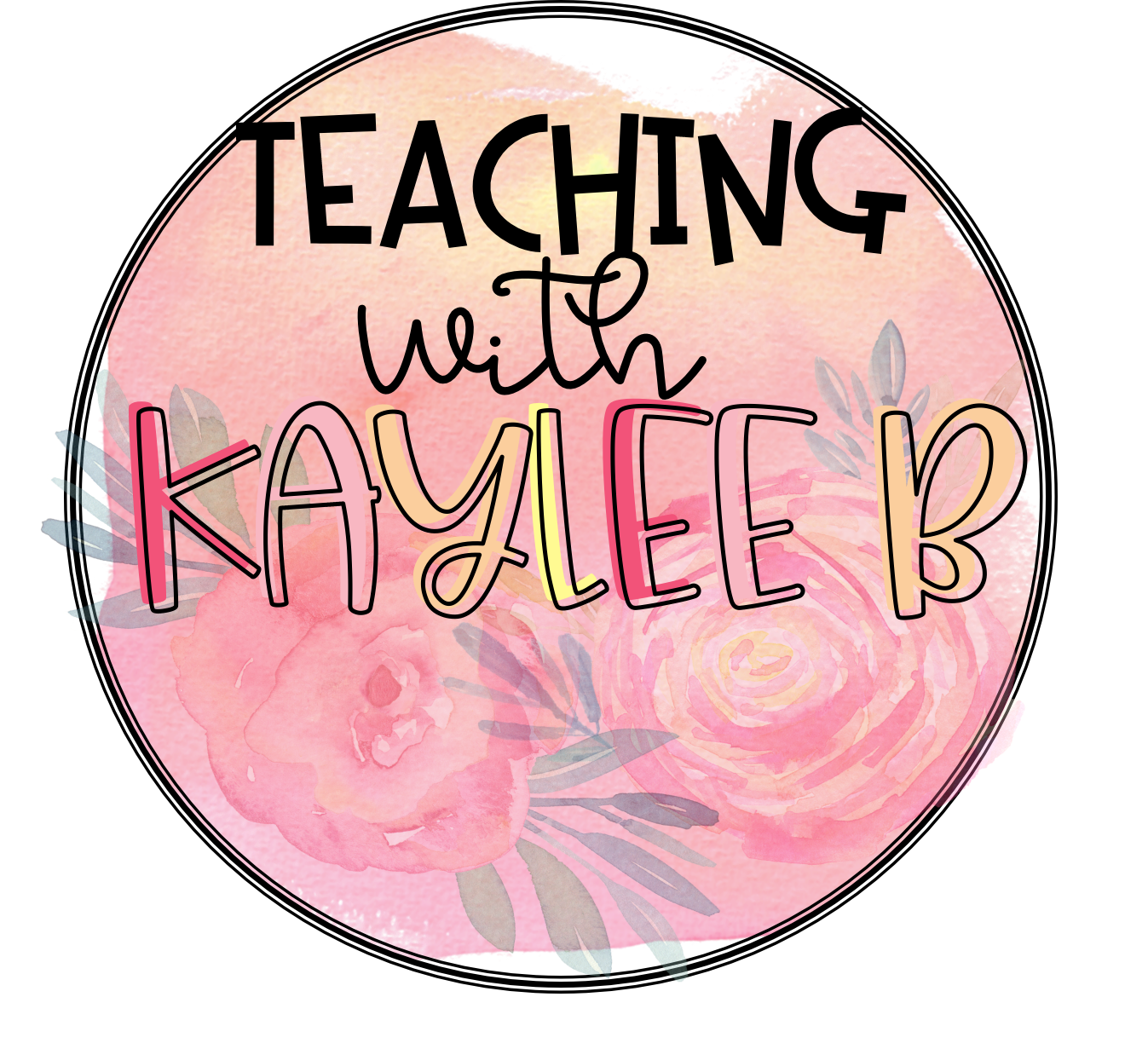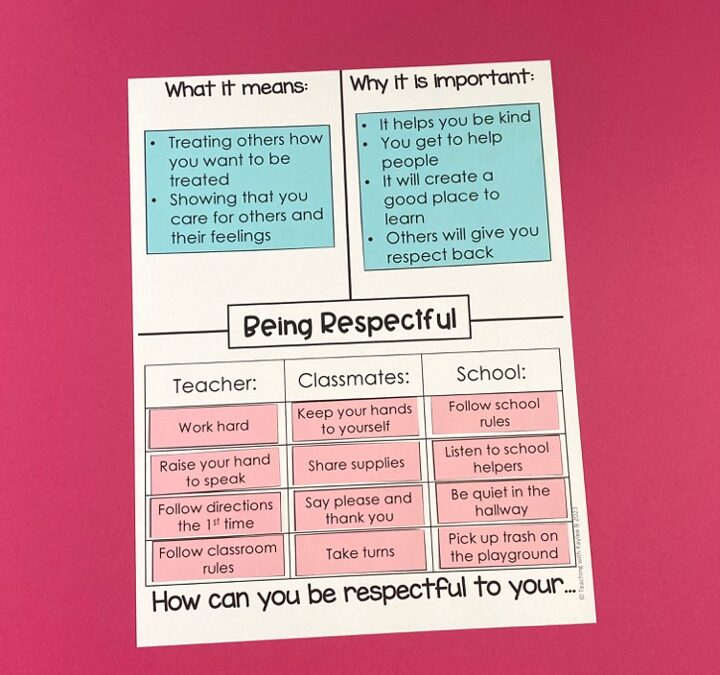When it comes to choosing class rules for your elementary classroom, I love to use “be responsible and be respectful.” Children might not know what these mean at first, but today I am going to show you how to make a responsibility anchor chart and a respect anchor chart kindergarten through 2nd grade students can really benefit from.
But first I want to share why I love having these as class rules. Being respectful promotes positive social interactions. Students treat each other with kindness. They are considerate to their classmates and to me as the teacher. I also like to point out when I do things that show respect for my students. This helps students feel like the classroom is a safe place to learn. They can take chances and try new things because they know their teacher and classmates will treat them with respect even if they make a mistake. When students and teachers treat each other with respect, it establishes a positive rapport and fosters a healthy teacher-student relationship. This bond encourages open communication, trust, and collaboration.
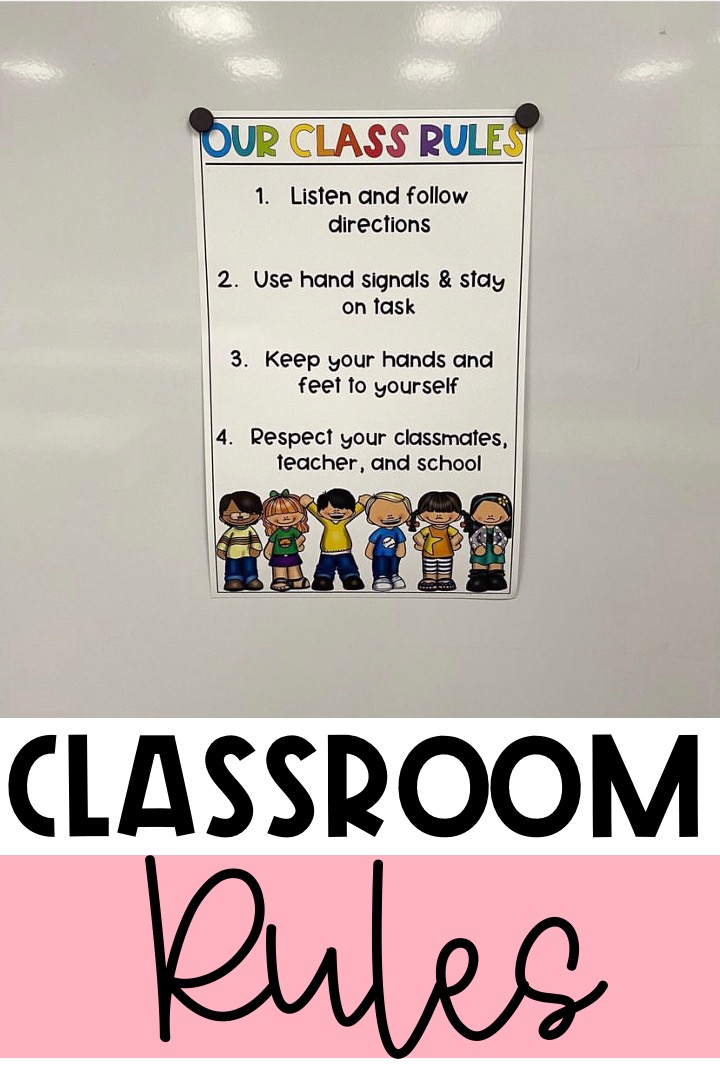
I love to have “be responsible” as a class rule because it helps students develop essential life skills. These skills help our day in the classroom run smoothly. Organization, time management, and accountability all fall under being responsible. These skills lay a foundation for future success both inside and outside the classroom. Having this rule encourages independence. Students learn to take ownership of their actions and choices. They develop self-discipline, autonomy, and a sense of pride in their accomplishments.
Now if you were to go ask a 6 year old what it means to be responsible or what it means to be respectful it will be hard for them to give you an answer if they haven’t had a lesson on those concepts.
That is why after I introduce our class rules, I teach what those rules really mean. Making a responsibility anchor chart and a respect anchor chart with my students is the most effective way to do this.
Responsibility Anchor Chart
Using anchor charts to teach both being responsible and being respectful make the lesson very visual for students. You can easily make these charts interactive for students. This makes the lesson engaging. Students get a clear understanding of the concept because you include student friendly definitions and use examples they can understand. I also love to display these charts in my classroom because I can reference them later when reinforcements and reminders are needed.
For my responsibility anchor chart, I split the anchor chart into four sections. I love the Mr. Sketch markers to do this. Find these markers here. They are the best for anchor charts! I put “Being Responsible” in the middle of the chart. Then I label other other sections as: What it means, Characteristics, Examples, and Nonexamples. I print out headers for these and it helps the chart look really nice. Find really good anchor chart paper to use here.
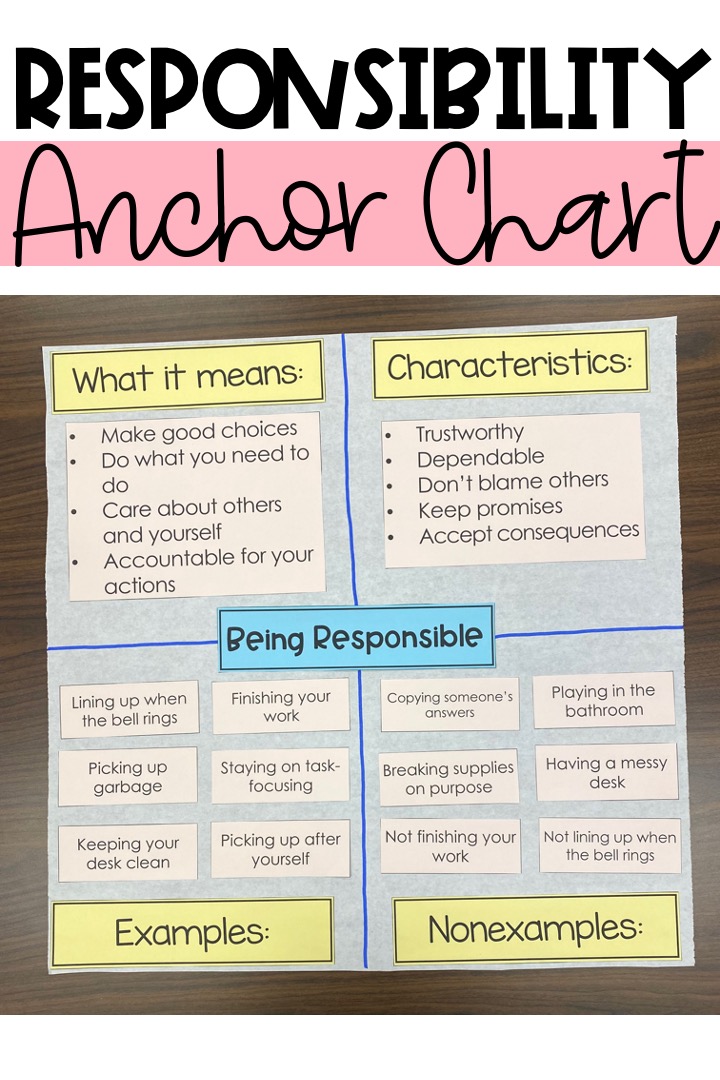
Once I get those glued on the chart, it is ready for the lesson. I like to make the rest of the chart with my students. It makes it more interactive with the kids. Plus, when you make an anchor chart with your students, they are more likely to reference it in the future.
To get started with the lesson, I read the book, “I am Responsible!” by David Parker. Before I read I tell my students to think about what it means to be responsible. After reading it, I ask my students to share their thoughts about what it means to be responsible.
Then I display the anchor chart and glue on the premade responses for “What it means.” Then ask students what are some other characteristics of people who are responsible. Or another way to put this is, “what else could we say about people who are responsible.” You can record student responses on the “Characteristic” section of the anchor chart or glue on the premade responses.
Here comes the really interactive part. I have cards that give scenarios of things that are responsible and things that are not responsible. I read a card and then have a student help me sort it on the responsibility anchor chart. I simply ask, “Is it an example of showing responsibility or is it not?” Then I glue it where it should go on the chart and continue this pattern until all the cards are gone. Find these cards and all my anchor chart pieces here.
I love how this anchor chart gives students a clear understanding of what it means to be responsible. When I see students do something responsible for the rest of the week, I like to point it out and say how that’s a good example.
But I like to take things one step further with our responsibility lesson. Making the anchor chart is direct instruction. For guided practice, I display a picture of some kids doing something responsible. For example, one picture has some kids cleaning up. I ask my students, “How is responsibility being shown?” I give my students 30 seconds to think about it on their own and then I have them turn and talk to a neighbor. Then I will call on a few students to share their thoughts with the entire class. Underneath the picture, I will record what they say. We continue this with a couple other pictures.
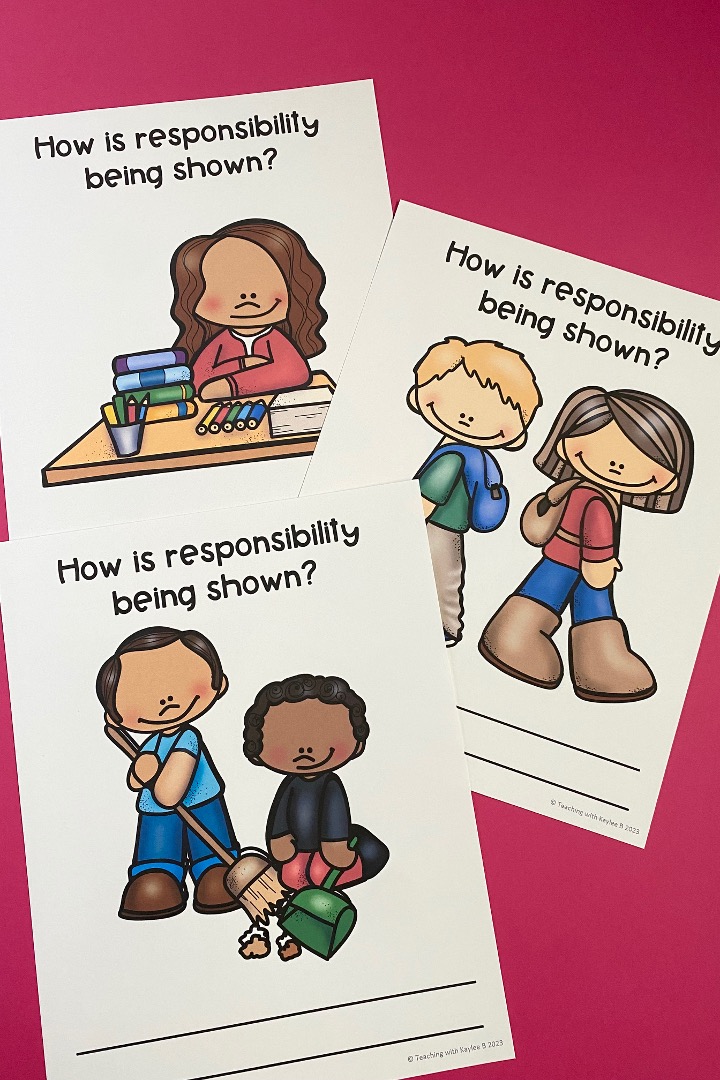
Find the pictures I use here.
For independent practice, I have my students think of an example of how they are going to be responsible this school year. I have them draw a picture and write a sentence to go with it. Then they share with a neighbor and I call on a few students to share theirs with the whole class.
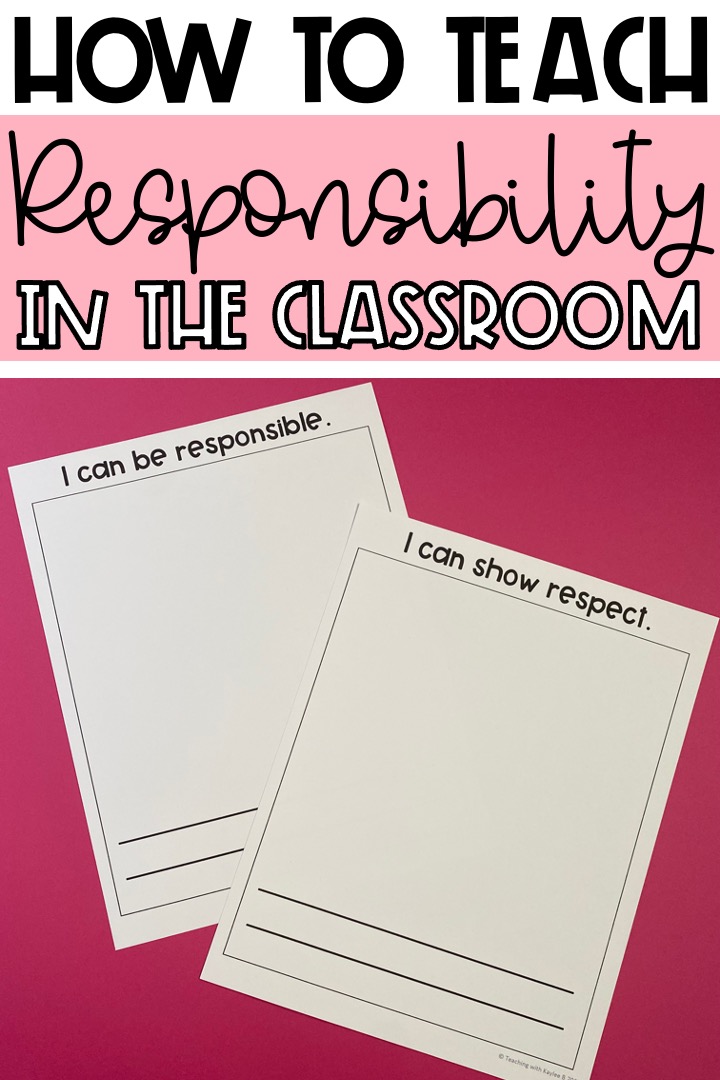
Find the worksheets I use for this activity here.
By explicitly teaching what it means to be responsible with my students at the beginning of the school year, it helps set up our class for success. Students take ownership of their choices. They clean up and work together. It helps create a positive classroom environment.
Now let’s move on to how I use a respect anchor chart for kindergarten, first grade, and second grade students.
Respect Anchor Chart for Kindergarten Through Second Grade
Just like with the responsibility anchor chart, I get this one ready before our actual lesson by splitting it into parts and gluing on the headers.This anchor chart has three parts: What it means, Why it is important, and How can you be respectful.
I read the book, “I Show Respect!” by David Parker. Before I read it, I tell my students to think about what it means to be respectful. After reading the book, we fill out the anchor chart together. I ask my students what it means to be respectful. I record their responses in that section. Then I ask why it is important to be respectful and record those responses.
Then comes the really interactive part. In the “How can you be respectful” section I have three different categories: teacher, classmates, and school. I read cards that have different scenarios. I call on students to help me sort these. Does the scenario show respect to the teacher, classmates, or the school? Then I glue the card where it should go.
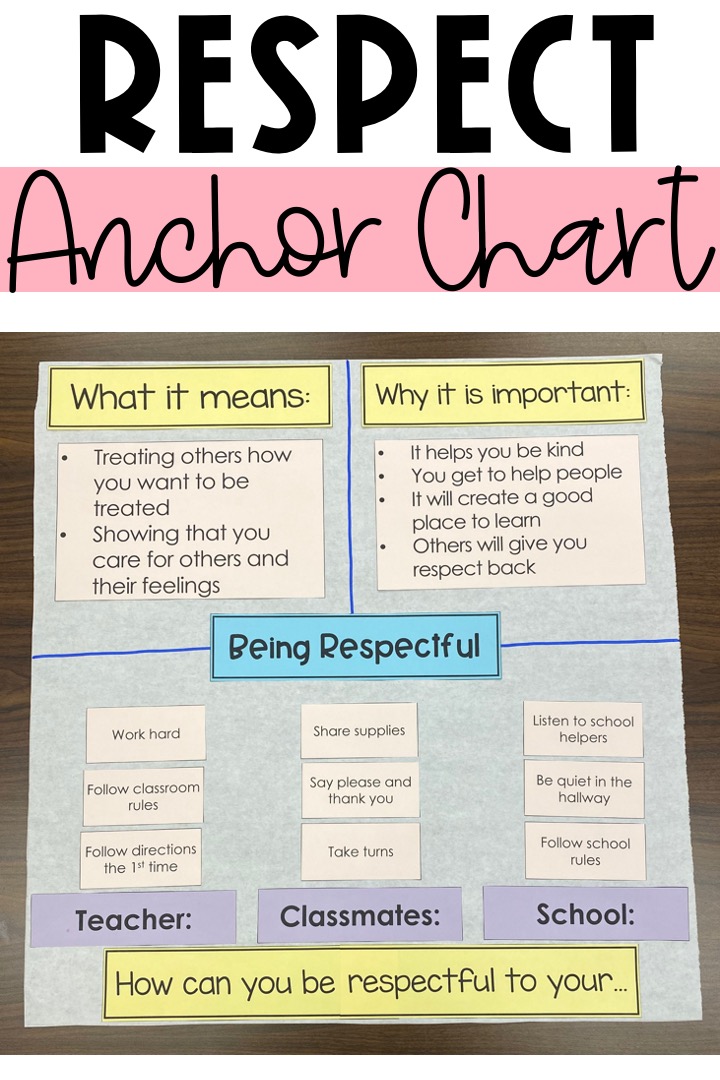
Find these respect anchor chart pieces I use here.
Completing the anchor chart together is the direct instruction part of our lesson. For guided practice I show a picture of kids showing respect in some way. I ask my students “How is respect being shown?” For example, there is one where there is a girl sitting quietly and listening. I have students think about the question for about 30 seconds, then they turn and talk to a neighbor. After that I call on a couple students to share their thoughts. A student might say that the student is showing respect by listening to the teacher and not talking to a neighbor. Find the pictures I use for this activity here.
For independent practice, I have my students think of an example of how they are going to be respectful this school year. I have them draw a picture and write a sentence to go with it. Then they share with a neighbor and I call on a few students to share theirs with the whole class. Find the worksheets I use for this activity here.
Being respectful and responsible are both important rules for the classroom. When you teach them explicitly and make the lesson engaging, it will help you have a successful school year.
Wanting to learn how to make these rules part of a class agreement with your students? Check out this blog post: How to Make a Class Agreement for Elementary
Get more classroom management ideas here: 5 Positive Strategies for Behavior Management in the Classroom
Check out how I explicitly teach classroom procedures and routines with my students here in this blog post: Top 9 Classroom Routines and Procedures, Number 3 is a Life Saver
As an Amazon Associate I earn from qualifying purchases.
